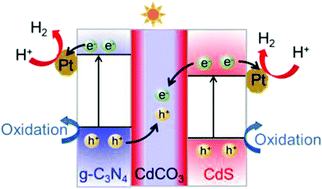Nanotwin and all-solid-state (ASS) Z-scheme heterojunction engineering are two widely used strategies for improving photocatalytic activity in H2 production. However, both strategies fail to produce a satisfactory effect when used alone due to their own limitations. Hence, combining nanotwin and ASS Z-scheme heterojunction engineering is expected to improve photocatalytic activity effectively. Herein, we report a nanotwinned ASS Z-scheme g-C3N4/CdCO3/CdS (CN/CC/CS) photocatalyst synthesized for the first time by in situ bridging of (CN) and (CS) with a (CC) conductor. The growth and ripening of CN/CC/CS are limited by thiourea (Tu) and CN. CN/CC/CS can improve charge carrier separation and transfer kinetics due to the synergetic advantages of its nanotwin structure, ASS Z-scheme junction, N–Cd chemically bonded interfaces, in situ intimate contact, and hierarchical architecture. The visible-light-driven H2 production rate of CN/CC/CS is 345% of that of CN/CS. This work proposes a new method for rationally designing novel materials with improved photocatalytic activity by combining heterojunction and defect engineering.

